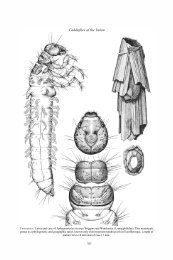Spiders of the Yukon - Department of Biological Sciences
Spiders of the Yukon - Department of Biological Sciences
Spiders of the Yukon - Department of Biological Sciences
Create successful ePaper yourself
Turn your PDF publications into a flip-book with our unique Google optimized e-Paper software.
<strong>Spiders</strong> <strong>of</strong> <strong>the</strong> <strong>Yukon</strong> 75<br />
Zoogeographical knowledge <strong>of</strong> <strong>the</strong> <strong>Yukon</strong> Territory’s spider fauna is almost nonexistent,<br />
and little has been published on o<strong>the</strong>r nor<strong>the</strong>rn regions. Koponen (1996) recently<br />
compared <strong>the</strong> known numbers <strong>of</strong> spider species in <strong>the</strong> faunas <strong>of</strong> nor<strong>the</strong>rn areas, and Marusik<br />
(1996) compared <strong>the</strong> species list from nor<strong>the</strong>astern Siberia with that <strong>of</strong> Finland. We attempt<br />
here, however tentatively, to list and analyze <strong>the</strong> species known to date from <strong>the</strong> <strong>Yukon</strong>.<br />
Much remains to be learned regarding <strong>the</strong> geographical relationships between <strong>the</strong>se species<br />
and those <strong>of</strong> nor<strong>the</strong>astern Asia and regarding Pleistocene refugia and <strong>the</strong> subsequent<br />
movement <strong>of</strong> spiders to <strong>the</strong>ir present ranges.<br />
The species list is based on collections made by many investigators during <strong>the</strong> past<br />
40 years, when collecting has been concentrated along <strong>the</strong> Alaska, Klondike, and Dempster<br />
Highways. The most intensive collecting was done by <strong>the</strong> third author and associates in 1993<br />
at Cultus Bay and <strong>the</strong> nearby mountains in Kluane National Park (61 o 11′N 138 o 20′W) and<br />
in <strong>the</strong> vicinity <strong>of</strong> Carmacks (62 o 11′N 136 o 22′W).<br />
The species list treats web-building species (Dictynidae to Hahniidae) first and hunters<br />
(Pisauridae to Salticidae) following. The sequence <strong>of</strong> families follows that <strong>of</strong> <strong>the</strong> British<br />
Columbia list (West et al. 1984, 1988), and generic and specific names are given alphabetically.<br />
Species are numbered for reference elsewhere in <strong>the</strong> article. A second list consists <strong>of</strong><br />
species which we believe, on current data, will be found by future collectors in <strong>the</strong> <strong>Yukon</strong>.<br />
Annotated List <strong>of</strong> Species <strong>of</strong> Araneae Recorded from <strong>the</strong> <strong>Yukon</strong><br />
Range types in this list that refer to East Beringia or West Beringia include species with<br />
ranges extending only as far west in Eurasia as <strong>the</strong> Yenisey River in Siberia (and south to<br />
Kamchatka and nor<strong>the</strong>rn Sakhalin), and only as far east in North America as Chesterfield<br />
Inlet, Northwest Territories (and south to nor<strong>the</strong>rn British Columbia). Species are also<br />
categorized as Arctic, Boreal, or Subarctic/Alpine, in accordance with whe<strong>the</strong>r <strong>the</strong>y occur<br />
mainly in one or ano<strong>the</strong>r <strong>of</strong> <strong>the</strong>se zones.<br />
Species marked ** are new records for <strong>the</strong> Nearctic Region.<br />
Family Dictynidae<br />
Most dictynids use sticky silk emitted from a flat spinning plate called <strong>the</strong> cribellum in<br />
web construction. Their irregular webs are <strong>of</strong>ten built at <strong>the</strong> tips <strong>of</strong> weeds or twigs, or among<br />
stones and plant debris on <strong>the</strong> ground. Ten species are known from <strong>the</strong> <strong>Yukon</strong>.<br />
1. Arctella lapponica (Holm) Palaearctic-East Beringian, Arctic<br />
Distribution: <strong>Yukon</strong>, northwestern Northwest Territories and nor<strong>the</strong>rn British Columbia; Scandinavia,<br />
Mongolia (Eskov 1989b).<br />
<strong>Yukon</strong> records: Cultus Bay, Kluane L.<br />
<strong>Biological</strong> information: On tussock tundra and under stones.<br />
2. Argenna obesa Emerton Nearctic, Boreal<br />
Distribution: <strong>Yukon</strong> to Newfoundland, south to Utah and New Jersey.<br />
<strong>Yukon</strong> records: S shore, Kluane L.<br />
<strong>Biological</strong> information: In litter.<br />
3. Argenna prominula Tullgren Holarctic, Boreal<br />
Distribution: Alaska to Manitoba, south to New Mexico; Scandinavia, nor<strong>the</strong>rn Siberia.<br />
<strong>Yukon</strong> records: Carcross; km 82 (North Fork Pass) and 141 Dempster Hwy.; Old Crow; British Mts.<br />
(68°54′N 140°23′W); Cultus Bay, Kluane L.; Rat L.; Carmacks.<br />
<strong>Biological</strong> information: In moss and litter in coniferous woods.<br />
Taxonomic notes: This species was known previously in North America as A. lorna Chamberlin and<br />
Gertsch (Aitchison-Benell and Dondale 1990).

















